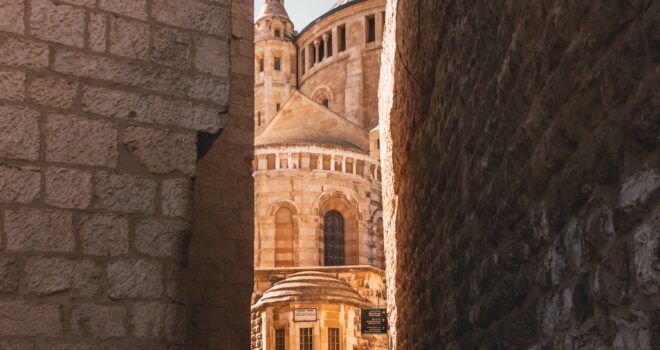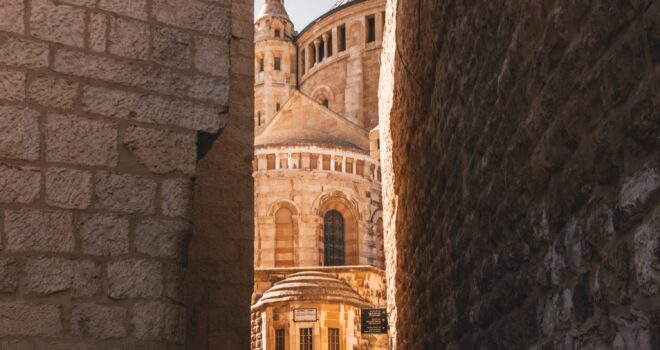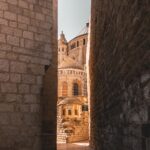Very quickly, think about a place in which you felt particularly connected to God. What were the qualities of the place that caused you to feel connected? Was the place connected to a particular group of people?
Now, quickly recollect some significant places from the salvation history and the Bible. The locales that came to mind might have included the Garden of Eden, Egypt, the desert, the Promised Land, Judea, Jerusalem, the Temple Babylon, Bethlehem, Nazareth, Cana, the Sea of Galilee, Mount Tabor, Bethany, Gethsemane, or Calvary (Golgotha). Other locations , which have a more mystical quality might have been the Ark of the Covenant, a synagogue, the Nativity creche, the garden of the Resurrection, the New Jerusalem, or the temple of the Holy Spirit.
Engaging in this moment of recollection can help us to understand the importance of place in God’s revelation and His plan for His Chosen People. Because we believe in the sacramental quality of dirt and stone and architecture, all of the locations listed above are anointed places in which God has met and encountered His Chosen People. Further, we believe that the People of God, and the individuals who are part of that People, can have an ongoing and deepening relationship with the Lord through these anointed places.
This truth is precisely why the idea of a pilgrimage is such an integral part of our Catholic faith, and our experience with God. The Mystical Body of Christ is a pilgrim people seeking, ultimately, to know and receive the divine Mystery in the New Jerusalem. Pilgrimages made by individuals or smaller groups to new places, and the transformation that happens by returning to profound places again and again, reflects that search. Thus, it is right and good to find these anointed places for our own lives, and to plan pilgrimages accordingly.
Our Catholic faith has plenty of obvious locales to which we can make pilgrimage. The Holy Land, often called the “fifth gospel,” seems to be the pinnacle of pilgrimage destinations. Rightly so. Those who have set foot in the Holy Land have spoken and written profusely of encountering Jesus and the Heavenly Father in new and profound ways. Without a doubt, it would be a special and memorable thing to walk the streets of Bethlehem, like Mary and Joseph did before the Nativity; to walk around or go fishing in the Sea of Galilee; to visit Nazareth and its towns, Cana and Capernaum; to pray at Bethany and the Garden of Gethsemane; to pray at the Temple wall; to traverse Jesus’ footsteps from Pilate’s praetorium to Golgotha; to lay eyes on the tomb in which Jesus was laid, the very site of the Resurrection.
Beyond pilgrimage to the Holy Land, there are the sites of ancient Christianity that were built during centuries of struggle and growth: cities such as Corinth, Philippi, Ephesus, and, especially, Rome. Specifically, these pilgrimage sites remind us that Christianity is a relationship with the Risen Lord that lasts a lifetime, through the vicissitudes of history and the struggles of facing pagan cultures. These places also remind us that an ongoing relationship with Jesus could lead us to martyrdom, as the witness of so many early Christian lives attest.
In addition to the obvious pilgrimage sites of classical Christian civilization, there are many “ordinary” destinations on every continent, in every country, that are open doors for encounter with the divine. I have written an ongoing series about pilgrimages to cities in the United States, such as Nashville, St. Louis, Peoria, Denver, Memphis, and New Orleans. Added to the cities, there are shrines across America that make great pilgrimage destinations over a weekend or even on a single day.
Still, if all of those are impossible for any reason, we can make pilgrimage in simple ways, any day of the year. We can make pilgrimage to our local parish for prayer and sacraments, especially the Mass. Each and every parish, particularly the church and the altar, are anointed as special places of encounter, set aside for the holy purposes of the Lord. Kneeling before a tabernacle is as profound as kneeling before the Ark of the Covenant in the Holy of Holies in the ancient Temple, because Jesus is the Eternal Holy of Holies. Because it is anointed by the Lord, venerating an altar is akin to venerating and embracing the True Cross. And, lastly, the Eucharist is a re-presentation of both Jesus’ perfect sacrifice on Calvary and His glorified body in the Resurrection. When we participate in Mass, we are veritably transported to the place of Jesus’ perfect offering and His restored glory.
When we are baptized, and then when we have received Jesus’ Body, Blood, Soul, and Divinity into ourselves, we are transformed into the temples of the Holy Spirit about which St. Paul writes (see 1 Cor. 6:19). Therefore, we can make pilgrimage to visit others who are on the pilgrimage of life with us. In his book, The Weight of Glory, C.S. Lewis reminds us, “Next to the Blessed Sacrament itself, your neighbor is the holiest object presented to your senses.” This is exactly why ministry to the sick and homebound is so spiritually fruitful. In greeting those people, any one of us ought to realize that they are the avenues by which God desires to reach out and encounter us, too.
So, let’s all recall that each day of this life is another step on the pilgrimage toward the eternal Promised Land. Let’s treat our journeys to the Holy Land or Rome or New Orleans as sacramental reminders of that bigger reality. Finally, let’s realize that the “average” settings and people we encounter also provide doors to the eternal Mystery whom we seek, and who seeks us. Blessed pilgrimages to you all!
Photo by Christian Burri on Unsplash












